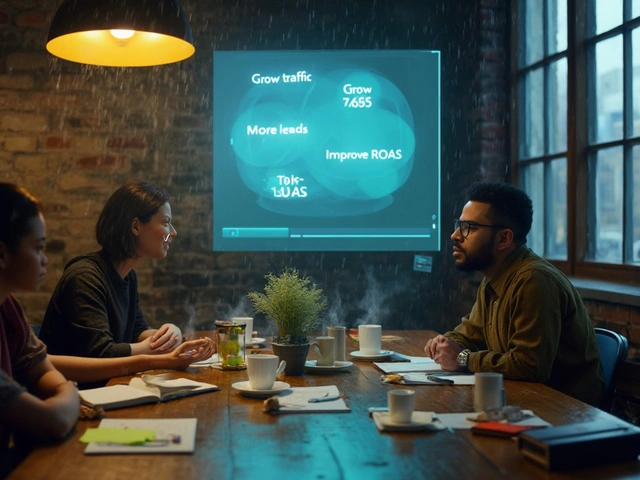You’re not trying to “use AI” for the sake of it-you want more traffic, leads, and revenue without burning your budget or your team. ChatGPT can do that, but only if you give it clear goals, the right context, and tight guardrails. This guide lays out a practical system you can lift into your marketing week: step-by-step setup, ready-to-run prompts, benchmarks, and checks so you move faster without losing quality.
- TL;DR: Treat ChatGPT like a junior marketer with superpowers-feed it strategy, voice, and data; review output; ship fast.
- Start with goals and a small pilot channel (SEO, ads, or email). Prove lift in 2-4 weeks, then scale.
- Use structured prompts, brand voice files, and reusable templates to keep output on-brand and accurate.
- Track a few core KPIs (CTR, CVR, CAC, ROAS, MER). If your numbers don’t move, your prompts or offer need work.
- Mind privacy and compliance. Never paste customer PII or secrets; use synthetic data for examples.
Build Your ChatGPT Marketing Engine: A Step-by-Step Playbook
If you’ve tried a few prompts and got meh results, that’s normal. ChatGPT shines when it knows your audience, offer, voice, and success metrics. This playbook gets you there.
Define one measurable goal per channel. Examples: “Increase non-brand organic clicks by 25% in 90 days,” “Cut Google Ads CPA from $45 to $35,” “Lift email click rate from 1.2% to 2%.” Anchor all prompts to these targets so the model optimizes for outcomes, not word count.
Create your Brand Voice and Knowledge file. Paste a short style guide (tone, banned words, reading level), 3-5 winning examples (best ad, best email, best landing page), product facts, and top FAQs. Keep it to 1-2 pages. Reuse this file in every prompt. Pro tip: label it “Brand Voice v1.2 - Updated [Month/Year]”.
Set up ChatGPT features that save hours. Use Advanced Data Analysis for spreadsheets and bulk content, Browse to cite current facts, Vision for creative checks, and custom GPTs (aka “GPTs”) for repeat workflows. If you use the API or tools like Zapier/Make, create automations for content drafting and approvals.
Run a rapid funnel audit (60 minutes). Map AARRR: Acquisition → Activation → Revenue → Retention → Referral. Where’s the biggest leak? A low CTR needs better angles; low CVR needs better offers/landing pages. Tell ChatGPT: “Given this funnel snapshot, propose 3 tests to unlock the next 20% lift.”
Pick one pilot track (2-4 weeks). Choose the highest-leverage channel right now: SEO content hub, Google Search ads, Meta creative refresh, email welcome series. Focus beats dabbling.
Build a reusable prompt system. Use this 6-part pattern: Role → Goal → Inputs → Constraints → Output format → Criteria for success. Example system prompt: “You are a performance marketer. Goal: increase ROAS on Google Search for [Product]. Inputs: [Voice file], [Keyword list], [Benefits], [Disclaimers]. Constraints: AU English, max 30-char headlines, no superlatives. Output: table of 15 headlines + 4 descriptions. Success: predicted CTR > 5%, shows unique angles.”
Use proven marketing heuristics. 40/40/20 Rule: Audience (40), Offer (40), Creative (20). If results stall, improve offer or targeting first. “3×3×3” creative testing: test 3 angles × 3 creatives × 3 audiences for signal in a week.
Ship weekly, analyze daily. Cadence I’ve used across B2C and B2B: Monday ship (new assets live), Tue-Thu monitor (tweak bids/budgets), Friday review (what moved the KPI), plan next sprint. Keep a simple doc: Test → Hypothesis → Asset → KPI → Result → Next move.
Guardrails and review. Ask for sources when facts matter. Add “If you’re unsure, say so and ask for missing info.” For compliance-heavy niches (finance, health), add: “Flag any claim that might require legal review; include a ‘Proof/Source needed’ note.”
Scale once unit economics work. When your CAC < LTV/3 or ROAS > target, expand to new audiences or geos. Use ChatGPT to localize copy (e.g., AU tone and currency) and to generate briefs for new landing pages.
When I roll this out with clients, I keep ChatGPT in the loop from idea to QA. It drafts, I edit, it sanity-checks, I ship. That collaboration cuts production time by 50-70% without losing brand voice. This is where ChatGPT marketing pays off.

Prompts, Templates, and Real-World Examples That Actually Ship
Use these exactly as written and swap the bracketed bits. Save your best performers as templates inside a custom GPT so your team can reuse them.
SEO content briefing
- Prompt: “Role: senior SEO strategist. Goal: brief a long-form article that can rank top 3 for [Keyword]. Inputs: [Brand Voice], top 10 SERP titles, People Also Ask, our unique POV: [POV]. Constraints: aim for information gain; include schema suggestions; AU English. Output: outline with H2/H3s, target intent, questions to answer, internal links, external primary sources to cite.”
- Ask for a gold, silver, bronze outline so you can pick scope based on effort.
- Then: “Draft intro (120-180 words) with a clear promise, no fluff. Include one stat from [Source] for credibility.”
Google Search ad generator
- Prompt: “Role: performance copywriter. Goal: lift Search CTR by 20%. Inputs: [Product], [Benefits], [Keywords], [Disallowed claims], [Brand Voice]. Constraints: 15 headlines (≤30 chars), 4 descriptions (≤90 chars), include price anchoring in 3 headlines, add AU spellings. Output: CSV-ready table with Headlines 1-15 and Descriptions 1-4.”
- Follow-up: “Predict the top 5 headline-description combos and why (angle, specificity, proof).”
- QA prompt: “Check each headline for policy risk under Google Ads Misrepresentation (Google Ads Help, 2024). Mark risky lines.”
Meta ads creative angles
- Prompt: “Role: UGC creative strategist. Goal: reduce CPA by 15% in 14 days. Inputs: 3 customer reviews, 2 objections, [Product demo points]. Output: 5 hooks, 5 20-second UGC scripts, 3 thumb-stopping first frames, 2 CTA variants. Format: storyboard bullets. Add an alternative for Australia’s spring/summer seasonality.”
Email welcome series (3-part)
- Prompt: “Role: lifecycle marketer. Goal: increase first-purchase rate from welcome flow. Inputs: [Brand Voice], [Offer], FAQ, top objection. Output: 3 emails: 1) value + story, 2) proof + social, 3) offer + urgency. Include subject lines (≤45 chars) and preheaders (≤60 chars).”
- Follow-up: “Give 3 alt versions tuned to mobile skimmers (max 100 words each).”
Landing page CRO
- Prompt: “Role: CRO specialist. Goal: lift conversion rate from 2.1% to 3.0%. Inputs: current URL copy, analytics snapshot (time on page, drop-off sections), 3 competitor angles. Constraints: keep hero under 25 words, add risk-reversal. Output: rewrites for hero, proof bar, offer stack, FAQs; plus 2 quick-win tests.”
Content repurposing workflow
- Prompt: “Role: content strategist. Goal: turn one article into a 14-day content plan. Inputs: [Article], [Audience segments], [Channels]. Output: 6 short posts, 2 carousels (text-only frames), 3 micro-videos scripts, 2 email snippets, 1 LinkedIn POV post. Include publishing cadence and UTMs.”
Competitor and ICP analysis
- Prompt: “Role: market researcher. Goal: clarify ICP and differentiation. Inputs: 3 competitor pages, our unique benefits, 10 customer quotes. Output: ICP profile (jobs, pains, gains), competitor claim map, our messaging matrix (feature → benefit → proof → objection → response).”
Analytics, budgets, and formulas
- ROAS = Revenue / Ad Spend. Target depends on margin. Services often fine at 3:1; low-margin ecommerce may need 4:1+.
- MER (blended ROAS) = Total Revenue / Total Marketing Spend. Good for omnichannel view.
- CAC = Spend / New Customers. LTV to CAC ratio: aim for 3:1 or better.
- CTR = Clicks / Impressions. CVR = Conversions / Clicks. CPA = Spend / Conversions.
| Channel | Typical CTR | Typical CVR | Avg CPC (USD) | Benchmark source (2024) |
|---|---|---|---|---|
| Google Search Ads | 4-8% | 3-10% | $1-4 | WordStream Google Ads Benchmarks |
| Google Display | 0.3-1% | 0.5-2% | $0.30-1 | WordStream Google Ads Benchmarks |
| Meta (Facebook/Instagram) | 0.9-1.8% | 1-5% | $0.50-1.50 | Meta Business Help Center summaries |
| LinkedIn Ads | 0.4-0.8% | 2-6% | $5-12 | LinkedIn Marketing Solutions |
| Email (click rate) | 1-3% | 1-5% | n/a | Mailchimp Email Benchmarks |
These are broad ranges that vary by industry and country. For Australia, I often see CPCs 10-30% higher than US benchmarks in B2B, and lower in niche local services. Always build your own baseline first.
Golden prompt cheat sheet
- “Before you answer, ask 3 clarifying questions.” Great to prevent off-target drafts.
- “Give 3 versions: safe, bold, contrarian.” Helps you find an angle with less ad fatigue.
- “Score your output 1-10 against this checklist: [Voice, Clarity, Proof, Specificity, Policy]. Then improve anything below 8.”
- “Produce the final as a JSON with fields [headline, body, CTA, angle] so I can import to Sheets.”
Ad testing plan (one-week sprint)
- Day 1: Generate 15 headlines + 5 bodies for Google; 5 UGC scripts for Meta; 3 LP headline variants.
- Day 2: Review and trim to 3 angles (Price, Speed, Proof). QA for policy and claims.
- Days 3-6: Run with capped budgets. Kill anything below 50% of account median CTR by 1,000 impressions.
- Day 7: Keep the top 1-2, write 5 siblings per winner. Repeat.
SEO content brief checklist
- Primary intent (informational, transactional?)
- People Also Ask questions to answer
- Information gain (what’s missing in top results?)
- Expert quotes or data to cite (Google, government reports, standards bodies)
- Internal links and schema type
- Visual plan (table, checklist, examples)
Landing page quick wins
- Clear promise in the first line (no fluff)
- Specific proof: numbers, names, timestamps
- Risk reversal: guarantee, free trial, cancel anytime
- 1 primary CTA above the fold and repeated
- FAQ that kills the top 3 objections
- Load speed under 2 seconds; minimize render-blocking scripts

Governance, Measurement, and Scaling: Avoid Wasted Spend
You want speed, not sloppiness. Here’s how to keep AI productive, safe, and tied to revenue.
Accuracy and hallucination control
- Ask for sources when facts affect decisions. Cite primary sources: Google Ads Help (policies and specs), Meta Business Help Center, Australian Competition and Consumer Commission for advertising rules, and government sites for stats.
- Use Browse for current facts and paste the key lines you’ll rely on. If the model can’t verify, don’t publish the claim.
- For numbers, add ranges and confidence notes: “Estimate; verify before publishing.”
Privacy and compliance
- Never paste PII (emails, phone numbers, card details) or confidential contracts. Use synthetic examples in prompts.
- In regulated verticals, require a “Compliance checklist” output: disclosures, risk language, banned terms.
- If you serve Australian customers, align with the Privacy Act and Australian Consumer Law on claims and testimonials.
Brand governance
- One page, one voice file. Keep it updated. Ban clichés and empty superlatives.
- Set a two-layer review: creator → approver. ChatGPT can assist both, but a human signs off on claims and legal.
- Build a “swipe file” of winning examples. Feed it back into prompts so quality improves over time.
Measurement that matters
- Pick 3-5 KPIs by channel. Example: SEO → non-brand clicks, ranking distribution, conversions; Ads → CTR, CVR, CPA/ROAS; Email → click rate, revenue per send.
- Add blended view: MER weekly. If MER improves while channel KPIs wobble, you’re growing efficiently.
- Decision rule: If a test doesn’t move its primary KPI by week 2, pivot the angle or offer-not just the copy.
Scaling playbook
- Once a channel hits target CAC/ROAS for 2-3 weeks, expand audiences and geos, then create a sibling landing page tailored to the winning angle.
- Repurpose winners across channels: best email subject → headline test; top UGC hook → hero line. Use ChatGPT to translate the angle, not just the words.
- Budget rule of thumb: scale winners by +20-30% per day to avoid algorithm shock on Meta/Google.
Pitfalls to avoid
- Prompt sprawl: 100 prompts, no system. Keep 10-15 core templates and iterate.
- Copy without offers: No angle beats a weak offer. Improve the deal or value prop first.
- Vanity metrics: Big impressions, low revenue. Tie every test to a funnel stage KPI.
Mini‑FAQ
- Q: Can ChatGPT replace my copywriter? A: No. It drafts and accelerates. Your team adds insight, proof, and taste.
- Q: How do I keep it on-brand? A: Use a voice file with dos/don’ts and winning examples. Ask the model to self‑score against the file.
- Q: What about SEO penalties for AI content? A: Search engines reward helpful, people-first content. Add real data, unique angles, and expert review.
- Q: Which model should I use? A: Use a current GPT-4 class model with Advanced Data Analysis for heavier tasks; lighter drafts can use a faster model. Always QA outputs.
- Q: How do I prevent wrong facts? A: Require sources, limit claims, and ask the model to list uncertainties before finalizing.
Next steps (2‑week plan)
- Day 1-2: Write your Brand Voice and Knowledge file. Pick one pilot (SEO, ads, or email). Define a single KPI.
- Day 3-4: Build 3 core prompts for that channel. Generate assets. QA for voice, proof, and policy.
- Day 5-10: Launch. Monitor daily. Kill losers fast, feed learnings back into prompts.
- Day 11-12: Ship round 2 with improved angles. Add 1 landing page tweak.
- Day 13-14: Review KPI movement. If you see lift, templatize. If not, upgrade the offer or targeting.
Troubleshooting by symptom
- Low CTR: Your hook is vague. Ask ChatGPT for three sharper angles anchored to outcomes (time saved, money saved, status gained) with numbers.
- High CTR, low CVR: Message‑market mismatch. Align ad promise with landing page copy; add proof (reviews, data) above the fold.
- Good CVR, high CPA: Try cheaper audiences/keywords; test lead magnets; iterate creative with cost‑per‑click in mind.
- Great content, no traffic: Add information gain, improve internal linking, and secure 3-5 relevant backlinks with outreach emails drafted by ChatGPT.
- Inconsistent tone: Tighten your voice file. Add 3 banned phrases and 3 “must-use” phrases.
What I’d do this week if we worked together
- Spin up a custom GPT preloaded with your voice file, ICP, and policy checks.
- Run a 3×3×3 ad test with two landing page headlines and one risk‑reversal variation.
- Publish one SEO article with a table and a checklist (information gain), then repurpose it into 5 shorts.
- Set a lightweight analytics doc with your KPIs and decision rules so you never guess what to do next.
Sources for claims and specs you can trust: Google Ads Help (ad policies, formats), Meta Business Help Center (ad specs and delivery), Mailchimp Email Marketing Benchmarks (engagement rates), LinkedIn Marketing Solutions (ad performance guidance), Australian Competition and Consumer Commission (advertising rules). I keep those open when I write, then ask ChatGPT to draft, check, and improve with those constraints in mind.


Write a comment